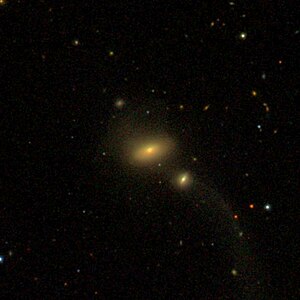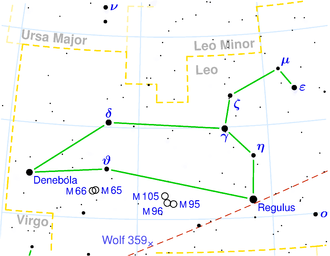NGC 3068
| Galaxy NGC 3068 |
|
|---|---|

|
|
| SDSS recording | |
| AladinLite | |
| Constellation | lion |
|
Position equinox : J2000.0 , epoch : J2000.0 |
|
| Right ascension | 09 h 58 m 39.1 s |
| declination | + 28 ° 52 ′ 27 ″ |
| Appearance | |
| Morphological type | E-S0 |
| Brightness (visual) | 14.4 mag |
| Brightness (B-band) | 15.4 mag |
| Angular expansion | 1.1 ′ × 0.9 ′ |
| Position angle | 53 ° |
| Surface brightness | 14.5 mag / arcmin² |
| Physical data | |
| Redshift | 0.021378 |
| Radial velocity | 6409 km / s |
|
Stroke distance v rad / H 0 |
(284 ± 20) x 10 6 ly (87.1 ± 6.1) Mpc |
| history | |
| discovery | Wilhelm Herschel |
| Discovery date | March 12, 1785 |
| Catalog names | |
| NGC 3068 • UGC 5353 • PGC 28815/87670 • CGCG 153-006 • MCG + 05-24-06 • 2MASX J09575667 + 1025562 • Arp 174 • GC 1974 • H III 293 • | |
NGC 3068 is an interacting pair of galaxies in the constellation Leo on the ecliptic . The galaxy pair is an estimated 284 million light-years from the Milky Way and consists of a lenticular galaxy (NGC 3068A) and an elliptical galaxy PGC 87670 (NGC 3068B).
Halton Arp organized his catalog of unusual galaxies into groups according to purely morphological criteria. This galaxy belongs to the class galaxies with narrow opposing arms .
The object was discovered by Wilhelm Herschel on March 12, 1785 .
Web links
Commons : NGC 3068 - collection of images, videos, and audio files
literature
- Jeff Kanipe and Dennis Webb: The Arp Atlas of Peculiar Galaxies - A Chronicle and Observer's Guide , Richmond 2006, ISBN 978-0-943396-76-7
